Material Model Effect for Simulating a Single-Lap Joint with a Blind Rivet
Abstract
:1. Introduction
2. The Object of the Test
2.1. The Geometry of Joints and Materials
2.2. Tension Test of the Joint
3. Analysis of Contact Stress
- The deformations were small and were within the elastic limit (the materials were subject to Hooke’s law);
- The bodies were limited by smooth surfaces of regular curvature;
- The contact area was much smaller than the characteristic dimensions of the bodies in contact;
- Each body can be considered a flexible half-space;
- Only normal stresses occur on the contact surface;
- The surfaces were friction-free.
- —Young’s Modulus of the material of part 1;
- —Young’s Modulus of the material of part 2;
- —the Poisson’s ratio of the material of part 1;
- —the Poisson’s ratio of the material of part 2.
4. Numerical Analysis
4.1. Discrete Model and Assumptions
- The right end of the sheet and the right additional surface (fixed support—all degrees of freedom were fixed);
- The end of the sheet and left additional surface (allowed displacement: x = free, y = 0, z = 0);
- The left end the external load (force F, N) acting in the x-direction;
- sheet-to-sheet frictionless contact;
- sheet(hole)-to-rivet—rough contact.
4.2. Results of the Numerical Analysis
5. Comparison of Results
6. Conclusions
- The selection of the material strength modeling method influences the results in the numerical strength analysis of the riveted joint in the entire load area (even for small values of the loading force, discrepancies in the results were observed);
- For small values of the force (about 10% of the load capacity of the riveted joint), too high values of elongation are observed in the numerical results, compared to the experimental ones (about 6% higher);
- The greatest difference in the deformation results was observed for the loads that comprise approximately 90% of the connection capacity. The highest difference was equal to 19.11%, and it was observed in the configuration of nonlinear materials. The linear model presents a smaller error (about 11%);
- It is assumed, by standards, that the allowable force should not exceed 311 N. It has been shown that, in this load range (from 0–30% of the maximum force transmitted by the riveted joint—1036 N), the selected material model does not have a significant impact on the numerical analysis results;
- An undervaluation of the maximum contact stress values (in the case of analytical pressure stress calculation) for higher values of the tensile force was observed;
- The stress values estimated using Hertz’s stresses were too high (20–40 times) compared to the results of the numerical analyses. These values, even for small load forces (e.g., 100 N), give values that exceed five times the tensile strength for the analyzed materials;
- The method of material modeling did not have a large impact on the maximum value of contact stresses obtained, as estimated by numerical methods.
Author Contributions
Funding
Institutional Review Board Statement
Informed Consent Statement
Data Availability Statement
Conflicts of Interest
Appendix A
| Experimental Work | Numerical Parameters | Linear-Linear | Nonlinear | |
|---|---|---|---|---|
| Bilinear-Linear | Bilinear-Bilinear | |||
| displacement s, mm 0.034063 | Maximum Total Deformation, mm | 0.0362 | 0.0361 | 0.0361 |
| Maximum Equivalent Stress, MPa | 54.9 | 54.9 | 54.9 | |
| Maximum Total Deformation for rivet, mm | 0.01982 | 0.0198 | 0.0198 | |
| Maximum Equivalent Stress for rivet, MPa | 50.0 | 50.3 | 50.3 | |
| Maximum Shear Stress in rivet, MPa | 11.6 | 11.6 | 11.6 | |
| Minimum Shear Stress in rivet, MPa | −11.9 | −12 | −12 | |
| Experimental Work | Numerical Parameters | Linear-Linear | Nonlinear | |
|---|---|---|---|---|
| Bilinear-Linear | Bilinear-Bilinear | |||
| displacement s, mm 0.08766 | Maximum Total Deformation, mm | 0.0731 | 0.0725 | 0.0725 |
| Maximum Equivalent Stress, MPa | 108.4 | 114.7 | 114.7 | |
| Maximum Total Deformation for rivet, mm | 0.04004 | 0.0397 | 0.0397 | |
| Maximum Equivalent Stress for rivet, MPa | 98.1 | 99.2 | 99.2 | |
| Maximum Shear Stress in rivet, MPa | 22.6 | 25.1 | 25.1 | |
| Minimum Shear Stress in rivet, MPa | −24.2 | −25 | −25 | |
| Experimental Work | Numerical Parameters | Linear-Linear | Nonlinear | |
|---|---|---|---|---|
| Bilinear-Linear | Bilinear-Bilinear | |||
| displacement s, mm 0.254326 | Maximum Total Deformation, mm | 0.2198 | 0.2182 | 0.2182 |
| Maximum Equivalent Stress, MPa | 388.8 | 403.5 | 238.3 | |
| Maximum Total Deformation for rivet, mm | 0.1202 | 0.1194 | 0.1194 | |
| Maximum Equivalent Stress for rivet, MPa | 313.4 | 146.6 | 146.6 | |
| Maximum Shear Stress in rivet, MPa | 111.9 | 82.3 | 82.3 | |
| Minimum Shear Stress in rivet, MPa | −110.1 | −81.5 | −80.2 | |
| Experimental Work | Numerical Parameters | Linear-Linear | Nonlinear | |
|---|---|---|---|---|
| Bilinear-Linear | Bilinear-Bilinear | |||
| displacement s, mm 0.321017 | Maximum Total Deformation, mm | 0.2924 | 0.2909 | 0.2911 |
| Maximum Equivalent Stress, MPa | 548.3 | 531.2 | 230.1 | |
| Maximum Total Deformation for rivet, mm | 0.1598 | 0.1594 | 0.1596 | |
| Maximum Equivalent Stress for rivet, MPa | 474.6 | 151.7 | 153.4 | |
| Maximum Shear Stress in rivet, MPa | 158.6 | 83.4 | 82.2 | |
| Minimum Shear Stress in rivet, MPa | −156.8 | −83 | −82.8 | |
| Experimental Work | Numerical Parameters | Linear-Linear | Nonlinear | |
|---|---|---|---|---|
| Bilinear-Linear | Bilinear-Bilinear | |||
| displacement s, mm 0.3668414 | Maximum Total Deformation, mm | 0.32664 | 0.30055 | 0.29676 |
| Maximum Equivalent Stress, MPa | 805 | 577.3 | 231.3 | |
| Maximum Total Deformation for rivet, mm | 0.17856 | 0.16471 | 0.16272 | |
| Maximum Equivalent Stress for rivet, MPa | 721.2 | 164.3 | 166.9 | |
| Maximum Shear Stress in rivet, MPa | 176.5 | 84.1 | 83.4 | |
| Minimum Shear Stress in rivet, MPa | −176.1 | −84 | −83.3 | |
References
- Li, G.; Shi, G.; Bellinger, N.C. Assessing the riveting process and the quality of riveted joints in aerospace and other applications. Weld. Join. Aerosp. Mater. 2012, 6, 181–214. [Google Scholar]
- Moraes, J.; Jordon, J.; Su, X.; Barkey, M.; Jiang, C.; Ilieva, E. Effect of process deformation history on mechanical performance of AM60B to AA6082 self-pierce riveted joints. Eng. Fract. Mech. 2018, 209, 92–104. [Google Scholar] [CrossRef]
- Korbel, A.; Szymczyk, E.; Skorupa, A. Eksperymentalna i numeryczna analiza procesu instalacji nitu. Biuletyn. WAT 2013, 62, 181–200. [Google Scholar]
- Yuan, X.; Yue, Z.; Yan, W.; Wen, S.; Li, L. Experimental and analytical investigation of fatigue and fracture behaviors for scarfed lap riveted joints with different lap angle. Eng. Fail. Anal. 2013, 33, 505–516. [Google Scholar] [CrossRef]
- Elzaroug, M.; Kadioglu, F.; Demiral, M.; Saad, D. Experimental and numerical investigation into strength of bolted, bonded and hybrid single lap joints: Effects of adherend material type and thickness. Int. J. Adhes. Adhes. 2018, 87, 130–141. [Google Scholar] [CrossRef]
- Marannano, G.V.; Zuccarello, B. Numerical experimental analysis of hybrid double lap aluminum-CFRP joints. Compos. Part B Eng. 2015, 71, 28–39. [Google Scholar] [CrossRef] [Green Version]
- Kudryavtsev, A.A. Plastic Deformations under Initial Conditions of Contact Problem of Mechanics (Case Study of Riveted Joints); Atlantis Press: Dordrecht, The Netherlands, 2018. [Google Scholar] [CrossRef] [Green Version]
- Kafie-Martinez, J.; Keating, P.B.; Chakra-Varthy, P.; Correia, J.; de Jesus, A. Stress distributions and crack growth in riveted lap joints fastening thick steel plates. Eng. Fail. Anal. 2018, 91, 370–381. [Google Scholar] [CrossRef]
- Nejad, R.M.; Tohidi, M.; Darbandi, A.J.; Saber, A.; Shariati, M. Experimental and numerical investigation of fatigue crack growth behavior and optimizing fatigue life of riveted joints in Al-alloy 2024 plates. Theor. Appl. Fract. Mech. 2020, 108, 102669. [Google Scholar] [CrossRef]
- Armentani, E.; Greco, A.; De Luca, A.; Sepe, R. Probabilistic Analysis of Fatigue Behavior of Single Lap Riveted Joints. Appl. Sci. 2020, 10, 3379. [Google Scholar] [CrossRef]
- Choi, D.-H.; Han, D.-W.; Kim, H.-K. Fatigue life estimation of self-piercing riveted aluminum joints under mixed-mode loading. Int. J. Fatigue 2017, 97, 20–28. [Google Scholar] [CrossRef]
- Rao, H.M.; Kang, J.; Huff, G.; Avery, K. Structural Stress Method to Evaluate Fatigue Properties of Similar and Dissimilar Self-Piercing Riveted Joints. Metals 2019, 9, 359. [Google Scholar] [CrossRef] [Green Version]
- Kam, D.-H.; Jeong, T.-E.; Kim, M.-G.; Shin, J. Self-Piercing Riveted Joint of Vibration-Damping Steel and Aluminum Alloy. Appl. Sci. 2019, 9, 4575. [Google Scholar] [CrossRef] [Green Version]
- Jeong, T.-E.; Kam, D.-H.; Kim, C. Parametric Investigation of Effect of Abnormal Process Conditions on Self-Piercing Riveting. Appl. Sci. 2020, 10, 2520. [Google Scholar] [CrossRef] [Green Version]
- He, X.; Deng, C.; Zhang, X. Fretting Behavior of SPR Joining Dissimilar Sheets of Titanium and Copper Alloys. Metals 2016, 6, 312. [Google Scholar] [CrossRef] [Green Version]
- Bula, K.; Sterzyński, T.; Piasecka, M.; Różański, L. Deformation Mechanism in Mechanically Coupled Polymer–Metal Hybrid Joints. Materials 2020, 13, 2512. [Google Scholar] [CrossRef] [PubMed]
- Armentani, E.; Laiso, M.; Caputo, F.; Sepe, R. Numerical FEM Evaluation for the Structural Behaviour of a Hybrid (bonded/bolted) Single-lap Composite Joint. Procedia Struct. Integr. 2018, 8, 137–153. [Google Scholar] [CrossRef]
- Pitta, S.; Carles, V.D.L.M.; Roure, F.; Crespo, D.; Rojas, J.I. On the static strength of aluminium and carbon fibre aircraft lap joint repairs. Compos. Struct. 2018, 201, 276–290. [Google Scholar] [CrossRef]
- Pitta, S.; Roure, F.; Crespo, D.; Rojas, J.I. An Experimental and Numerical Study of Repairs on Composite Substrates with Composite and Aluminum Doublers Using Riveted, Bonded, and Hybrid Joints. Materials 2019, 12, 2978. [Google Scholar] [CrossRef] [Green Version]
- Piątek, B.; Siwowski, T.; Michałowski, J.; Błażewicz, S. Development of Bonded/Riveted Steel Anchorages of Prestressed CFRP Strips for Concrete Strengthening. Materials 2020, 13, 2217. [Google Scholar] [CrossRef]
- Witek, L.; Lubas, M. Experimental Strength Analysis of Riveted Joints Using Blind Rivets. J. KONES 2019, 26, 199–206. [Google Scholar] [CrossRef] [Green Version]
- Kang, S.; Kim, H. Fatigue strength evaluation of self-piercing riveted Al-5052 joints under different specimen configurations. Int. J. Fatigue 2015, 80, 58–68. [Google Scholar] [CrossRef]
- Presz, W.; Cacko, R. Analysis of the influence of a rivet yield stress distribution on the micro-SPR joint—Initial approach. Arch. Civ. Mech. Eng. 2010, 10, 69–75. [Google Scholar] [CrossRef]
- Du, Z.; Duan, L.; Jing, L.; Cheng, A.; He, Z. Numerical simulation and parametric study on self-piercing riveting proces of aluminium–steel hybrid sheets. Thin-Walled Struct. 2021, 164, 107872. [Google Scholar] [CrossRef]
- Al-Bahkali, E. Finite Element Modeling for Thermal Stresses Developed in Riveted and Rivet-Bonded Joints. Int. J. Eng. Technol. IJET-IJENS 2011, 11, 86–92. [Google Scholar]
- nternational Organization for Standardization. ISO 12996:2013—Mechanical Joining—Destructive Testing of Joints–Specimen Dimensions and Test Procedure for Tensile Shear Testing of Single Joints; International Organization for Standardization: Geneva, Switzerland, 2013. [Google Scholar]
- Polish Committee for Standardization. PN-EN 485-2+A1:2018-12. Aluminium and Aluminium Alloys—Sheet, Strip and Plate—Part 2: Mechanical Properties; Polish Committee for Standardization: Warsaw, Poland, 2018. [Google Scholar]
- Polish Committee for Standardization. PN-EN 573-3:2019-12. Aluminium and Aluminium Alloys—Chemical Composition and Form of Wrought Products—Part 3: Chemical Composition and Form of Products; Polish Committee for Standardization: Warsaw, Poland, 2019. [Google Scholar]
- Fischer-Cripps, A.C. Introduction to Contact Mechanics; Springer: Berlin/Heidelberg, Germany, 2007. [Google Scholar]
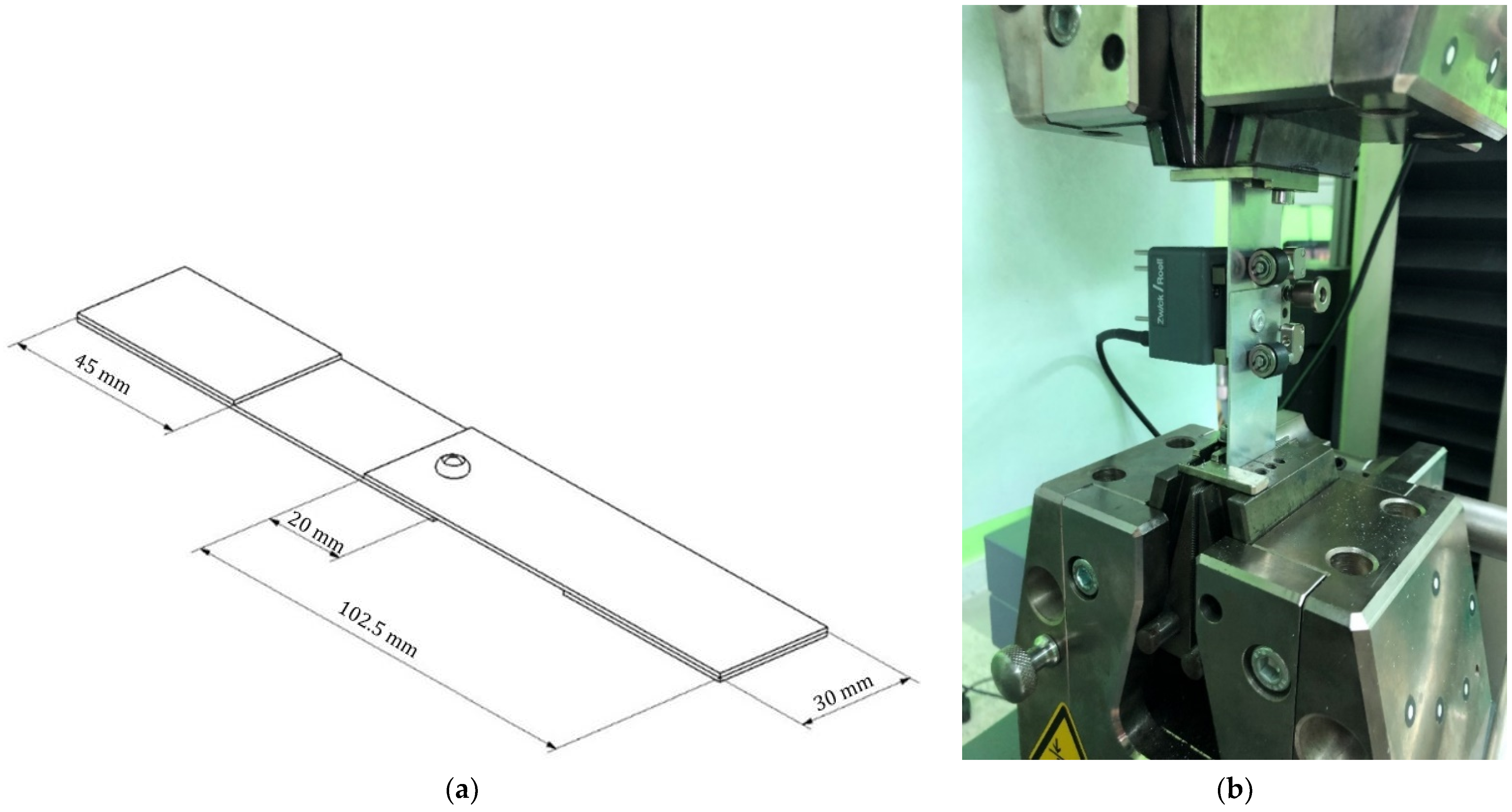
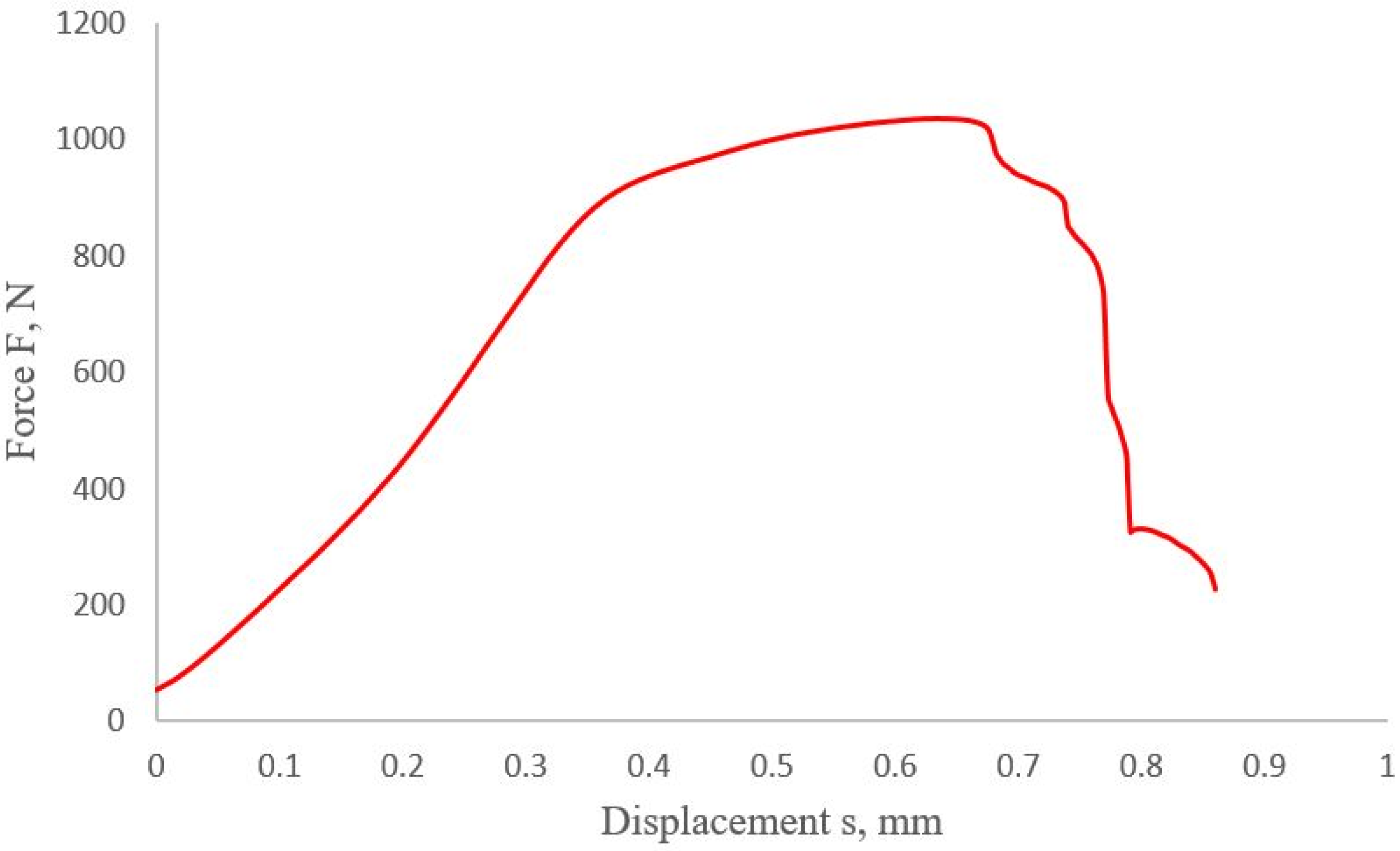


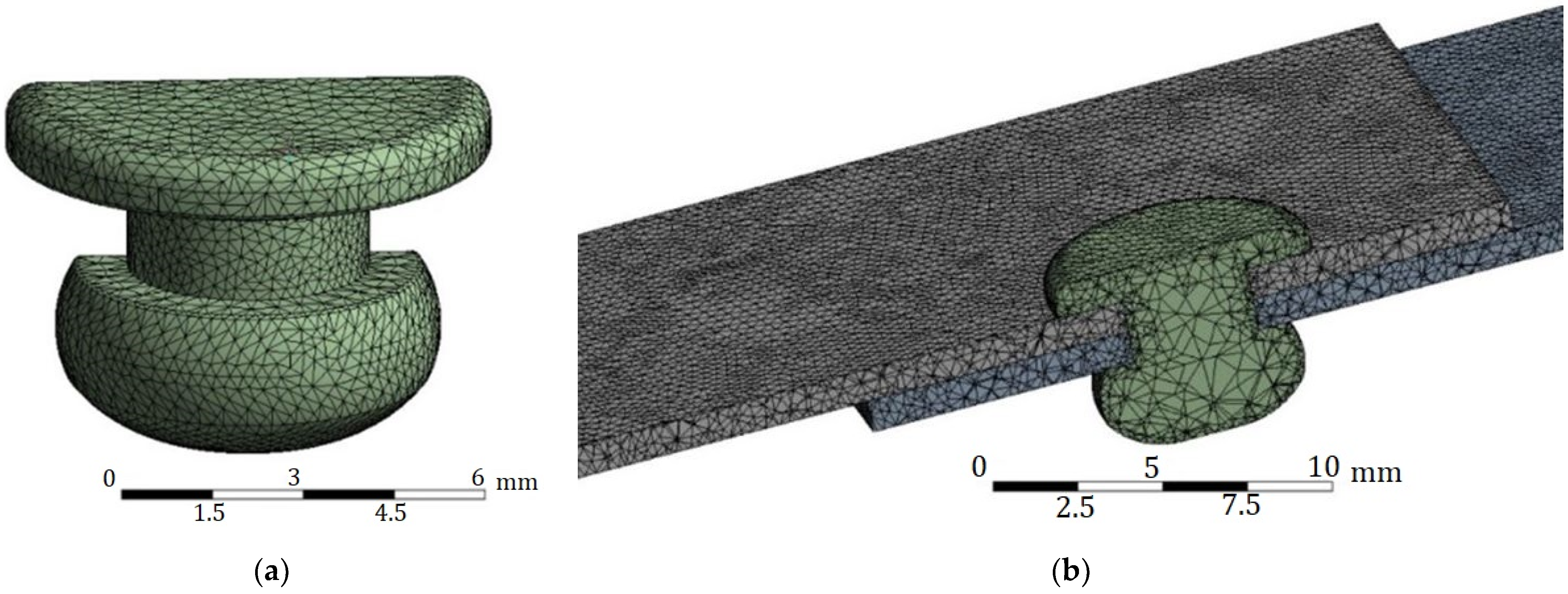
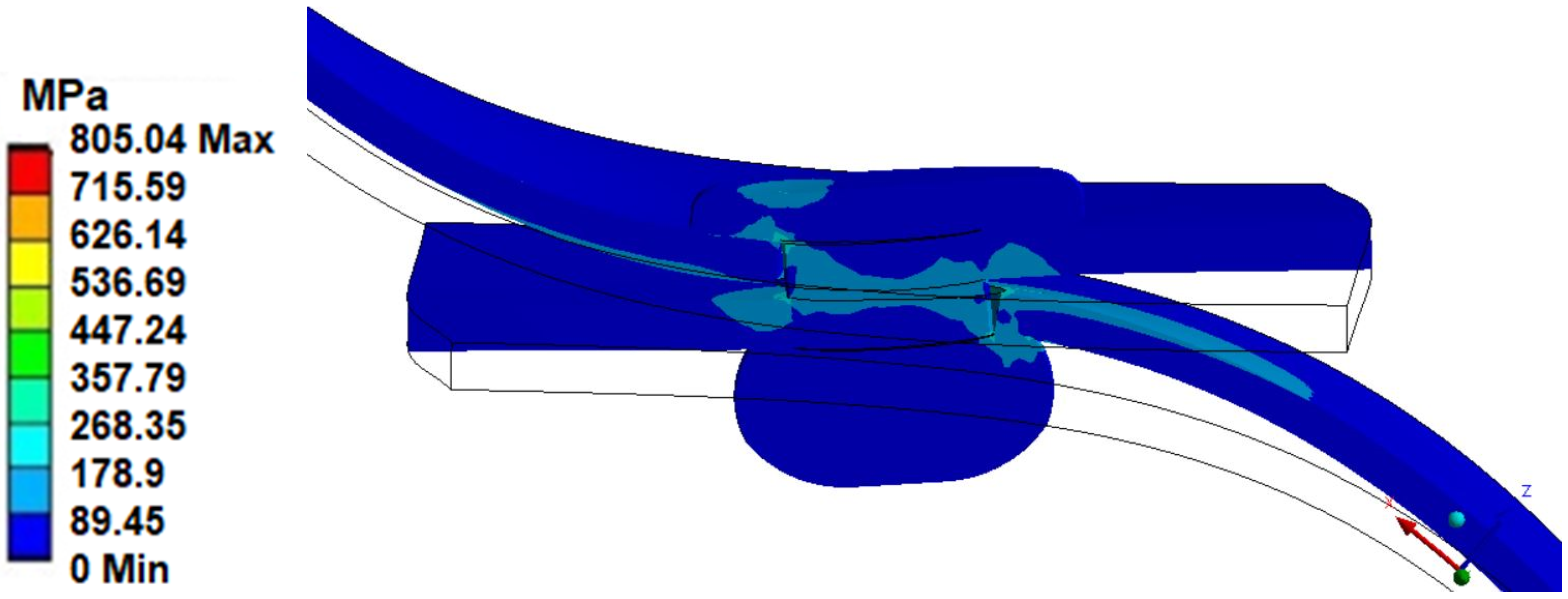


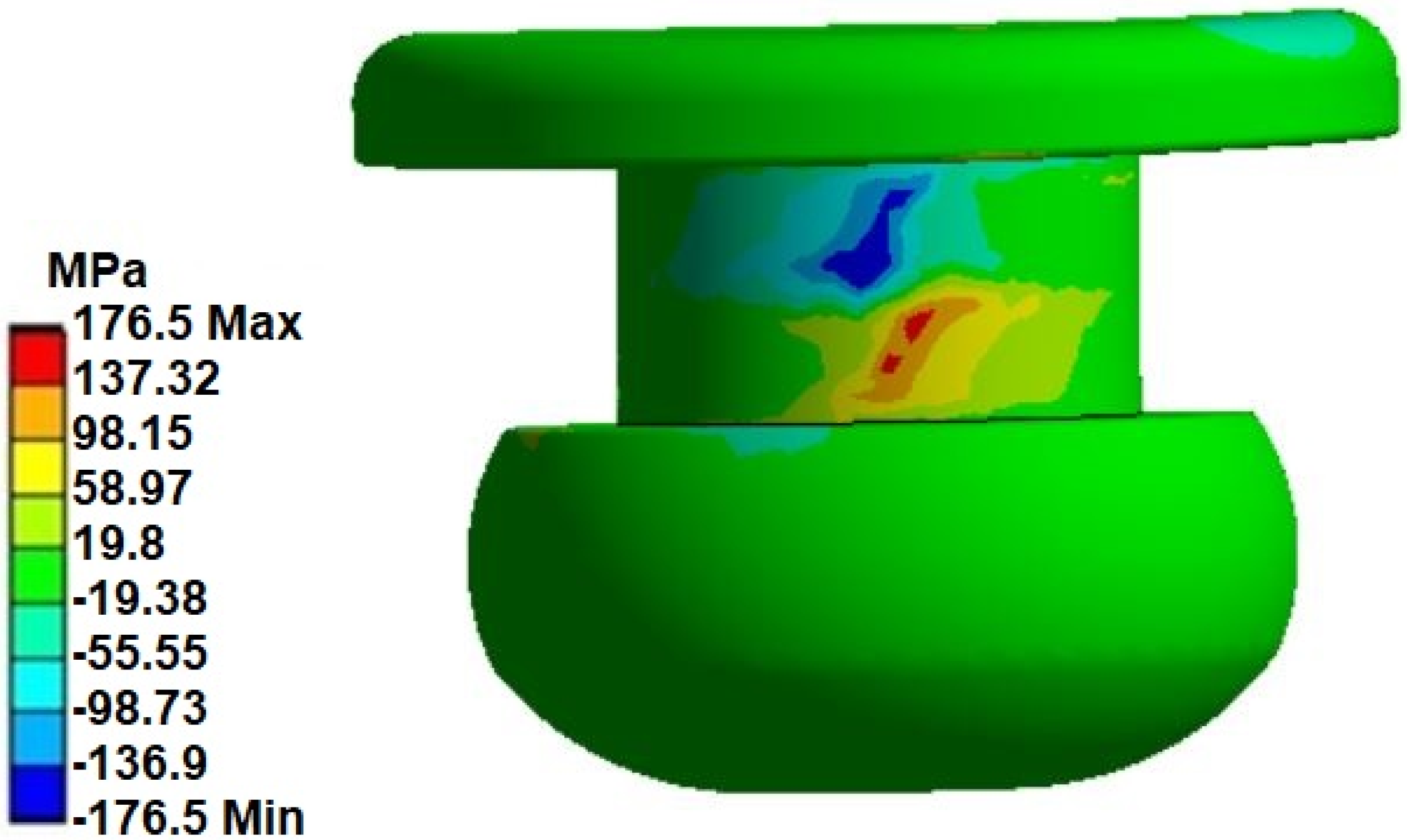
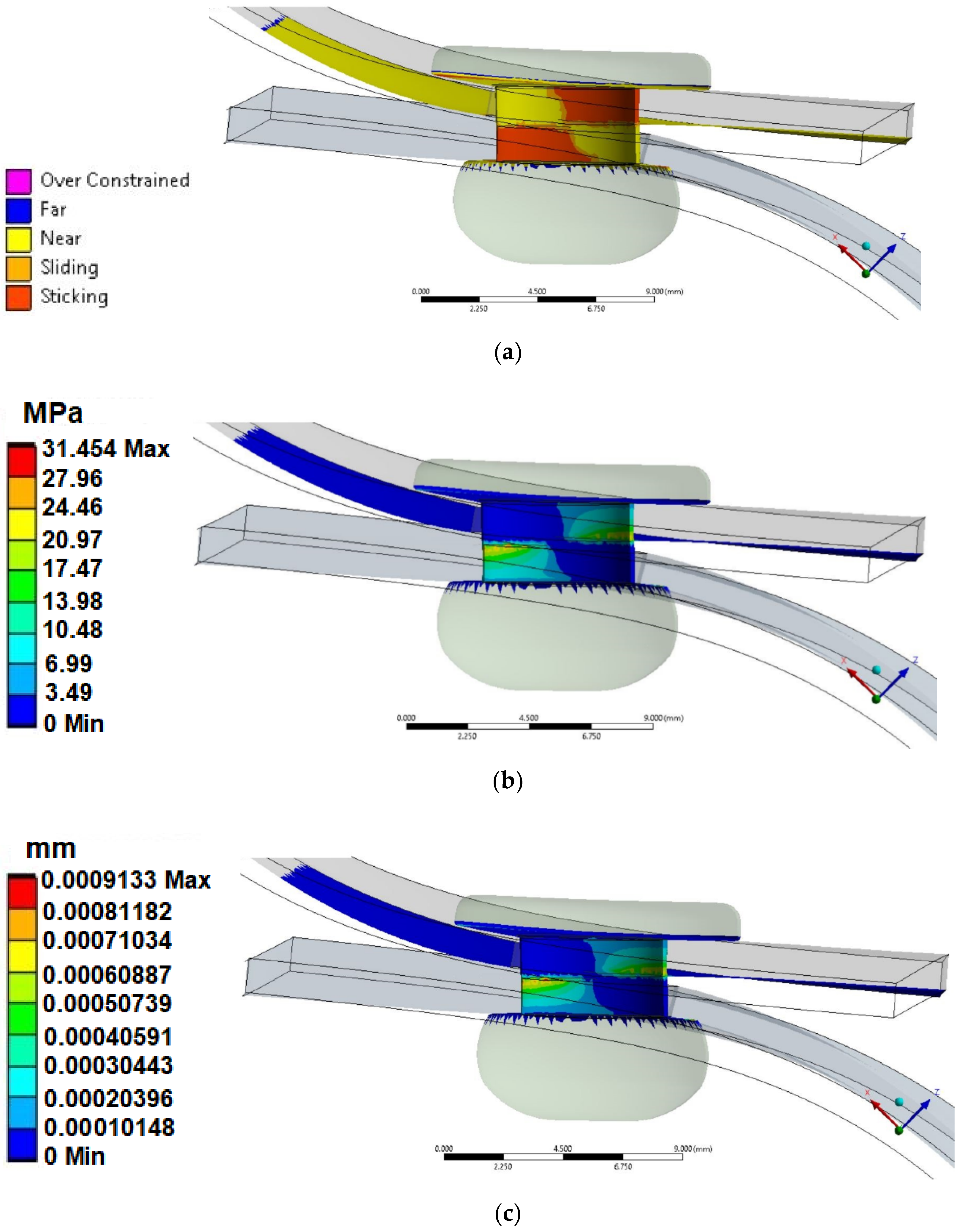
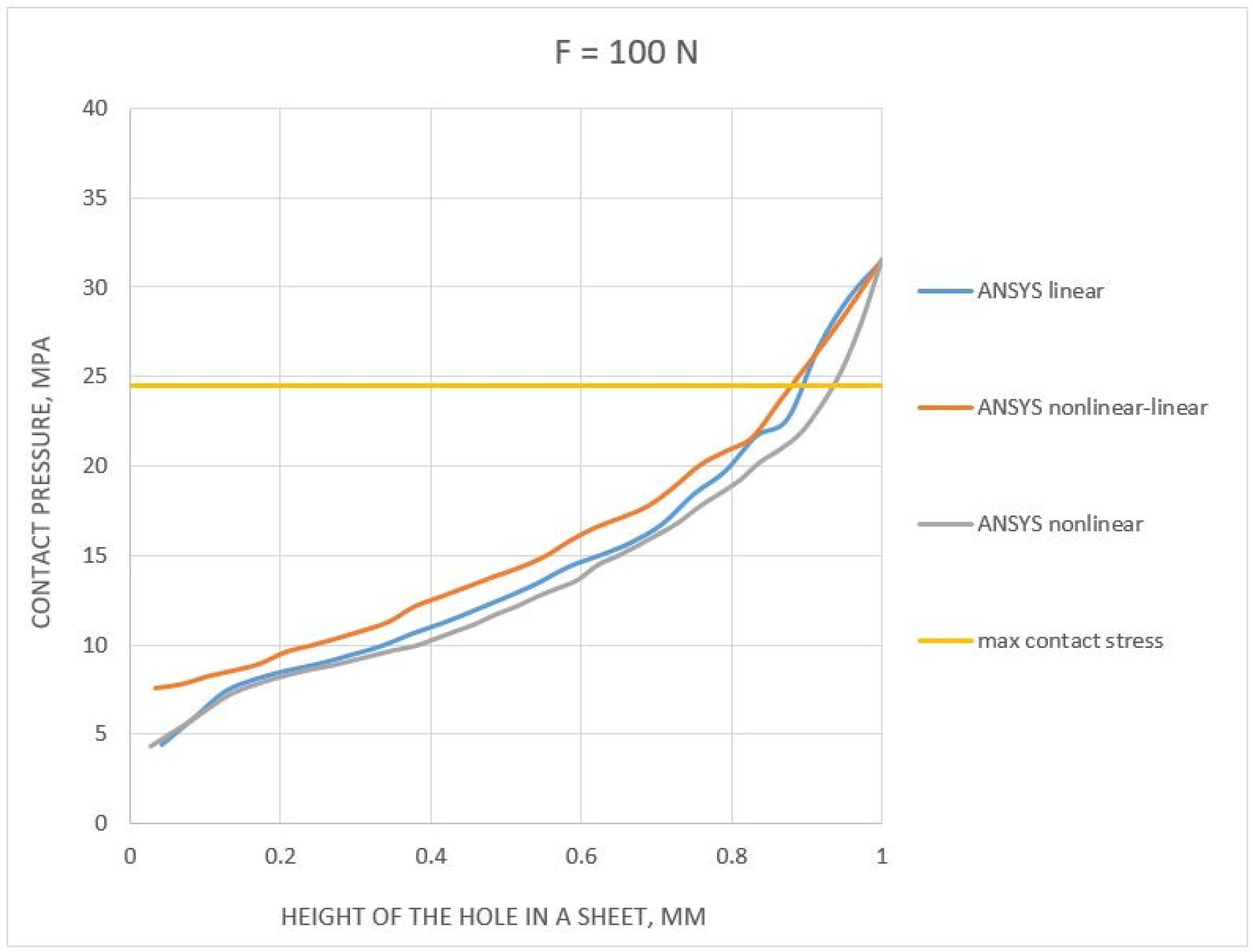
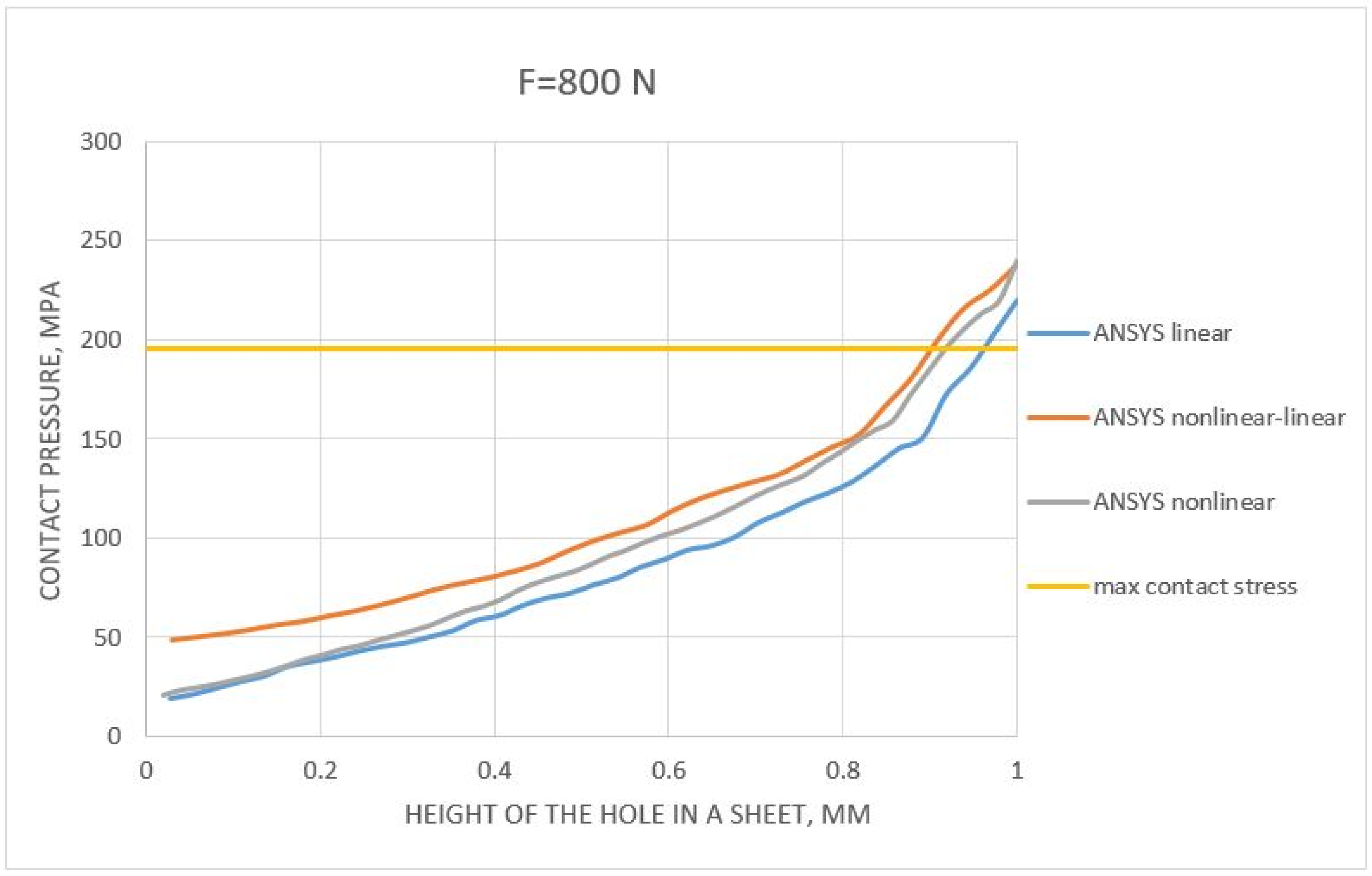

| Aluminum Alloy | Young Modulus E, GPa | Poisson’s Ratio | Yield Stress Rp0.2, MPa | Ultimate Tensile Strength UTS, MPa |
|---|---|---|---|---|
| EN AW 2017A [27] | 72 | 0.3 | 140 | 210 |
| EN AW 5251 [28] | 68 | 0.3 | 110 | 200 |
| Force, N | Hertz Contact Stress, MPa | Pressure Stress (No Clearance), MPa |
|---|---|---|
| 100 | 1092.7 | 24.3 |
| 200 | 1543.5 | 48.6 |
| 400 | 2182.8 | 97.3 |
| 600 | 2673.4 | 146 |
| 800 | 3086.9 | 194.6 |
| 900 | 3274.2 | 219 |
| Material Data | Aluminum Alloy EN AW 2017A (Sheet) | Aluminum Alloy EN AW 5251 (Rivet) |
|---|---|---|
| Density, kg/mm3 | 2700 | 2700 |
| Young’s Modulus, GPa | 72 | 68 |
| Poisson’s ratio | 0.3 | 0.3 |
| Yield strength, MPa | 210 | 140 |
| Tangent modulus, MPa | 1200 | 1000 |
| Force F, N | Experiment | Linear-Linear | Linear-Linear | Nonlinear-Linear | Nonlinear-Linear | Nonlinear-Nonlinear | Nonlinear-Nonlinear |
|---|---|---|---|---|---|---|---|
| Total Deformation Maximum | |||||||
| 100 | 0.03406 mm | 0.0362 mm | 106.27% | 0.0361 mm | 105.98% | 0.0361 mm | 105.98% |
| 200 | 0.08766 mm | 0.0731 mm | 83.39% | 0.0725 mm | 82.71% | 0.0725 mm | 82.71% |
| 600 | 0.25432 mm | 0.2198 mm | 86.42% | 0.2182 mm | 85.79% | 0.2182 mm | 85.79% |
| 800 | 0.32101 mm | 0.2924 mm | 91.09% | 0.2909 mm | 90.62% | 0.2911 mm | 90.68% |
| 900 | 0.36684 mm | 0.3266 mm | 89.04% | 0.3005 mm | 81.93% | 0.2967 mm | 80.89% |
Publisher’s Note: MDPI stays neutral with regard to jurisdictional claims in published maps and institutional affiliations. |
© 2021 by the authors. Licensee MDPI, Basel, Switzerland. This article is an open access article distributed under the terms and conditions of the Creative Commons Attribution (CC BY) license (https://creativecommons.org/licenses/by/4.0/).
Share and Cite
Lubas, M.; Bednarz, A. Material Model Effect for Simulating a Single-Lap Joint with a Blind Rivet. Materials 2021, 14, 7236. https://doi.org/10.3390/ma14237236
Lubas M, Bednarz A. Material Model Effect for Simulating a Single-Lap Joint with a Blind Rivet. Materials. 2021; 14(23):7236. https://doi.org/10.3390/ma14237236
Chicago/Turabian StyleLubas, Monika, and Arkadiusz Bednarz. 2021. "Material Model Effect for Simulating a Single-Lap Joint with a Blind Rivet" Materials 14, no. 23: 7236. https://doi.org/10.3390/ma14237236






